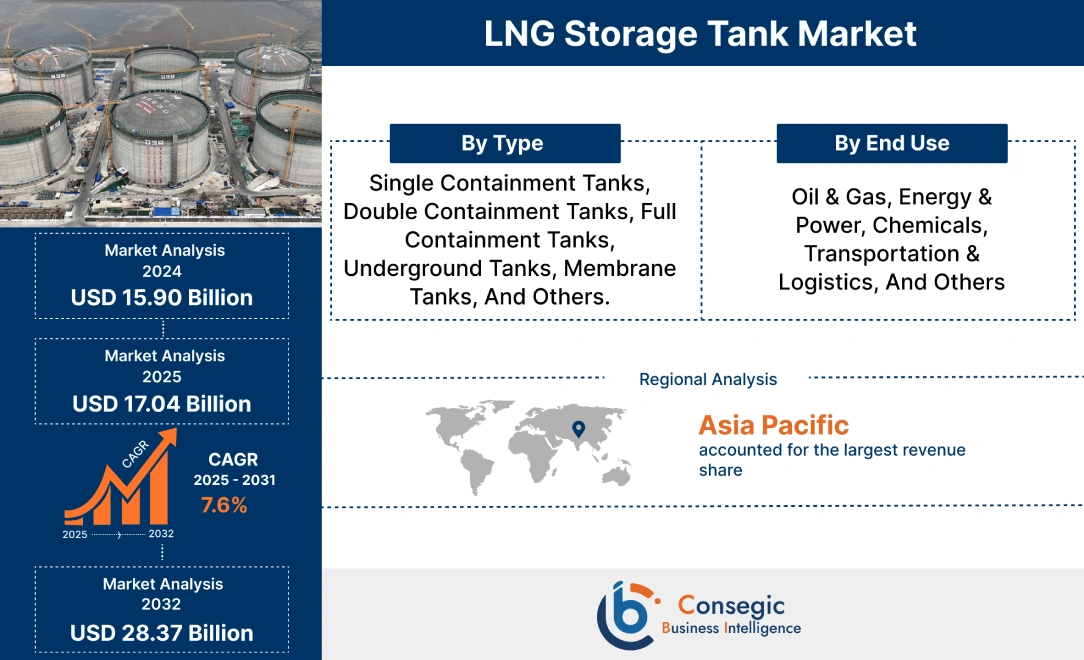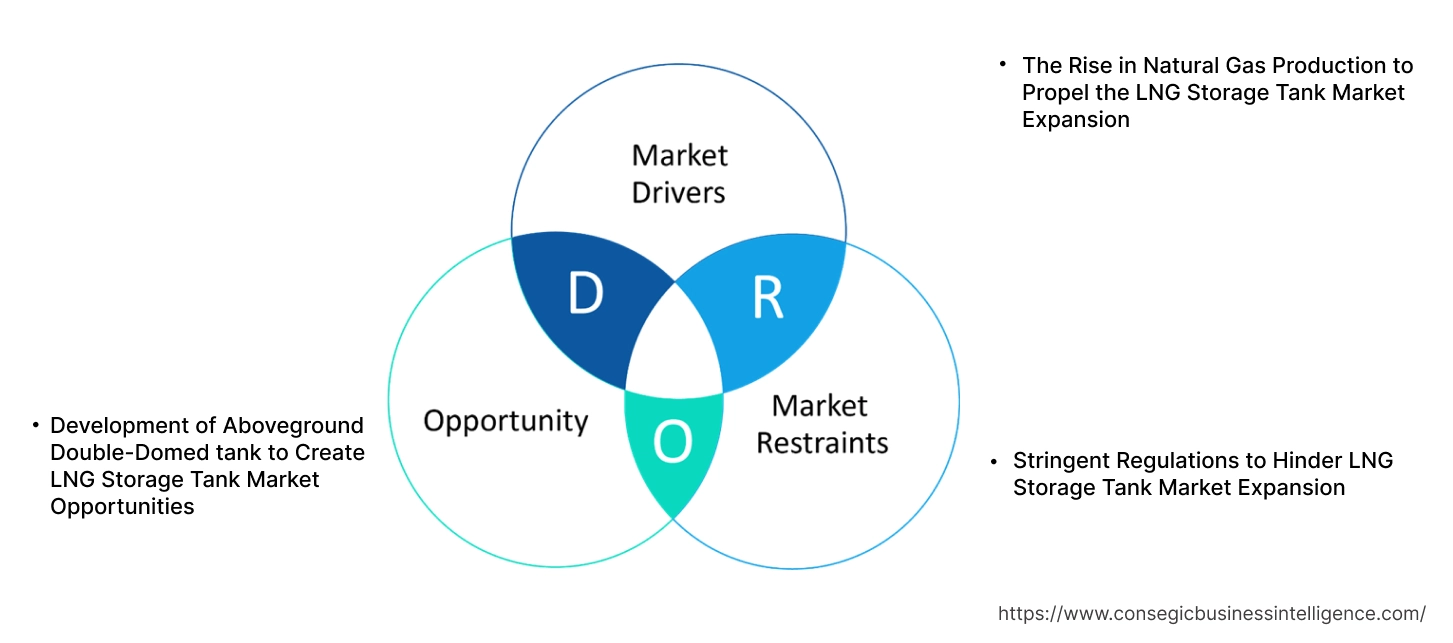LNG Storage Tank Market Size:
The LNG Storage Tank market size is growing with a CAGR of 7.6% during the forecast period (2025-2032), and the market is projected to be valued at USD 28.37 Billion by 2032 from USD 15.90 Billion in 2024. Additionally, the market value for 2025 is attributed to USD 17.04 Billion.
LNG Storage Tank Market Scope & Overview:
A Liquefied Natural Gas (LNG) storage tank is a highly specialized, insulated vessel that is designed to safely and efficiently store natural gas in its liquid state at extremely cryogenic temperatures, and low pressure. The primary purpose of liquefying natural gas is to significantly reduce its volume, making it economically viable for long-distance transport through specialized carriers or for large-volume storage at import/export terminals, peak-shaving facilities, and bunkering stations. Common types of these tanks offer the highest level of safety with enhanced inner and outer barriers. Each type is based on specific capacity, safety requirements, site conditions, and cost considerations for various onshore and offshore applications within the global energy infrastructure.
How is AI Transforming the LNG Storage Tank Market?
AI is playing a crucial role in the LNG storage tank market, particularly for enhancing safety through real-time monitoring and predictive maintenance, improving operational efficiency by automating inspection processes, and optimizing design for better structural resilience and capacity. Moreover, AI, combined with smart sensors, drones, and robotics, provides real-time monitoring and automated inspections of tanks. This reduces human exposure to hazardous environments, improves data accuracy, and ensures consistent operational conditions. Further, AI-powered design tools help engineers create more resilient and efficient LNG tank designs while minimizing material usage and maximizing storage capacity. Therefore, the above factors are expected to positively impact the market growth in upcoming years.
LNG Storage Tank Market Dynamics - (DRO) :
Key Drivers:
The Rise in Natural Gas Production to Propel the LNG Storage Tank Market Expansion.
As conventional natural gas extraction continues globally, a concurrent strategic pivot towards cleaner energy sources solidifies Liquefied Natural Gas as an important bridge fuel. This increased adoption leads to a greater need for liquefaction facilities, export terminals, and the cryogenic storage tanks which are essential for holding vast quantities of natural gas in their super-cooled liquid form. Production of crude oil and gas from offshore sites is influencing the use of Liquefied Natural Gas storage tanks.
For instance,
- In 2022, EIA, oil and natural gas production in the Federal Offshore Gulf of America accounted for about 15% of total U.S. crude oil production and about 2% of total U.S. dry natural gas production.
Thus, the rise in the production of natural gas is propelling the LNG Storage Tank market demand.
Key Restraints:
Stringent Regulations to Hinder LNG Storage Tank Market Expansion.
The expansion of the global Liquefied Natural Gas (LNG) storage tank industry faces a significant restraining factor in the form of stringent regulations. Given LNG's cryogenic nature and high flammability when vaporized, regulatory bodies worldwide impose exceptionally strict safety, environmental, and design standards on its storage infrastructure. These regulations mandate complex engineering solutions, such as double-containment or full-containment tank designs, advanced leak detection systems, extensive safety distances, and robust fire suppression capabilities, all of which significantly influence construction costs and increase project complexity. Additionally, the lengthy permitting and approval processes, mainly involving multiple governmental agencies and public hearings, introduce considerable delays into project timeline. As a result, the above-mentioned factors are limiting the LNG Storage Tank market demand.
Future Opportunities :
Development of Aboveground Double-Domed tank to Create LNG Storage Tank Market Opportunities.
The development of above-ground double-domed tanks represents a significant advancement creating substantial opportunities in the LNG Storage Tank Market. This innovative design consists of both an inner and outer dome, mainly with the outer dome constructed from strong materials such as prestressed concrete. This configuration offers enhanced safety and environmental protection by providing dual containment for the cryogenic liquefied natural gas, drastically reducing the risk of leaks, spills, and vapor dispersion in the event of an inner tank breach. Furthermore, the double-domed structure provides superior insulation and structural integrity, minimizing boil-off gas rates and ensuring greater resistance to external impacts or seismic activity. These inherent safety and efficiency benefits make these tanks highly attractive to regulatory bodies and project developers, enabling the approval and construction of larger capacity terminals in more diverse locations, including urban-proximate areas.
For instance,
- In 2025, CTCI Corporation announced that it has jointly won EPC bid with Japan’s IHI Plant Services Corporation (IPC) to build four above-ground, double-domed liquefied natural gas (LNG) cryogenic tanks, with a storage capacity of 180,000 kiloliters each, for CPC Corp., at CPC Kaohsiung Intercontinental LNG Terminal.
Thus, as per the market analysis, these advancements are making LNG tanks a more reliable, versatile, and appealing solution for a wider range of applications, thereby influencing the LNG Storage Tank market opportunities.
LNG Storage Tank Market Segmental Analysis :
By Type:
Based on type, the market is categorized into single containment tanks, double containment tanks, full containment tanks, underground tanks, membrane tanks, and others.
Trends in Type:
- The LNG Storage Tank market trends are influenced by ease of construction of single containment tanks, particularly for smaller volumes.
- The growing trend for enhanced safety and reduced environmental risk is influencing the use of double containment tanks.
The single containment tank segment accounted for the largest market share in 2024.
- A single containment tank is a basic storage design where the primary tank is the sole liquid-tight barrier for the stored product.
- The outer layer is primarily for insulation retention and vapor containment and is not designed to contain the liquid in the event of a primary tank failure, therefore, single containment tanks typically require an external bund wall to impound potential spills.
- The tank is a basic design features an inner tank made of cryogenic-suitable material to hold the liquefied natural gas, surrounded by insulation and an outer carbon steel shell.
- Crucially, the outer shell of a single containment tank is primarily designed to protect the insulation and contain vapor purge gas pressure, but it is not designed to contain the cryogenic liquid in the event of a leak from the inner tank.
- This means that if the inner tank fails, the outer shell is susceptible to brittle fracture upon contact with the extremely cold LNG.
- Thus, as per the market analysis, the aforementioned factors are driving the growth of the segment.
The double containment tanks segment is expected to grow at the fastest CAGR over the forecast period.
- Double containment tanks are a common and highly secure type of storage tank for Liquefied Natural Gas.
- They feature two independent, self-supporting containment barriers an inner primary tank, typically made of nickel steel or a similar cryogenic-resistant alloy, which directly holds the LNG at its extremely low temperature.
- Surrounding this primary tank is a secondary, outer tank, usually constructed of prestressed concrete or carbon steel, designed to independently contain the entire volume of LNG in the unlikely event of a leak or failure of the inner tank.
- This design significantly enhances safety by preventing uncontrolled liquid spillage and limiting the spread of any released LNG, thereby improving overall environmental protection and reducing potential hazards in the vicinity of the storage facility.
- Various investments are initiated for building and designing LNG tanks.
- For instance, in 2023, VINCI Construction Grands Projets, a subsidiary of VINCI Construction, have been selected to design and build a 180,000 m3 liquefied natural gas (LNG) tank in the Netherlands. This project falls within the programmed to expand the storage capacity and regasification of the Gas Access to Europe terminal, based in the port of Rotterdam, by making it possible to supply an additional 4 billion m3 of gas each year.
- Thus, owing to the aforementioned factors, the demand for double containment tanks is expected to grow at the fastest CAGR in the coming years.
By End Use:
Based on end use, the market is categorized into oil & gas, energy & power, chemicals, transportation & logistics, and others.
Trends in the End Use:
- The trends for storage tanks are influenced by increased global investment in clean energy technologies which is directly influencing the development LNG tank.
- Large LNG storage tanks are becoming integral to marine bunkering terminals to facilitate ship refueling.
The energy & power segment accounted for the largest LNG Storage Tank market share of 38.66% in 2024.
- LNG tanks are active components that allow for energy flexibility and security.
- Their primary function is to store liquefied natural gas at cryogenic temperatures, facilitating its transport from production sites to consumption markets, mainly across vast distances.
- This storage capability allows for the management of fluctuations, ensuring a continuous energy supply during peak consumption periods or disruptions to pipeline networks.
- Beyond direct supply, LNG storage supports the integration of intermittent renewable energy sources by providing a reliable, dispatchable energy backup.
- The rise in investment in clean energy technologies is influencing the growth of LNG tanks.
- For instance, the data by IEA states that Global energy investment is set to exceed USD 3 trillion in 2024, with USD 2 trillion going to clean energy technologies and infrastructure. Investment in clean energy has accelerated since 2020.
- Thus, as per the market analysis, the rise in the adoption of automotives is influencing segment share.
The transportation & logistics segment is expected to grow at the fastest CAGR over the forecast period.
- Liquefied Natural Gas (LNG) storage tanks are increasingly important in the transportation and logistics sector as industries seek cleaner, more cost-effective fuel alternatives.
- These specialized cryogenic tanks allow the efficient storage of natural gas in its liquid form at extremely low temperatures, which is denser than its gaseous state.
- This high energy density makes LNG an ideal fuel for long-haul and heavy-duty applications across various transport modes.
- For marine logistics, large storage tanks are integral to bunkering terminals, facilitating ship-to-ship or shore-to-ship refueling for LNG-powered vessels, which are rapidly gaining traction due to stricter emissions regulations.
- Hence, owing to the above-mentioned analysis, the transportation & logistics segment is expected to grow at the fastest rate over the future years, creating LNG Storage Tank market trends.
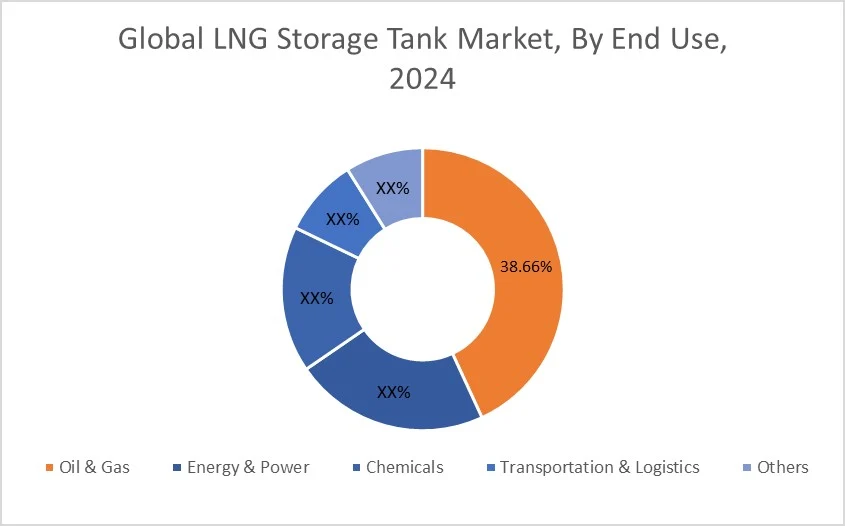
Regional Analysis:
The regional segment includes North America, Europe, Asia Pacific, the Middle East and Africa, and Latin America.
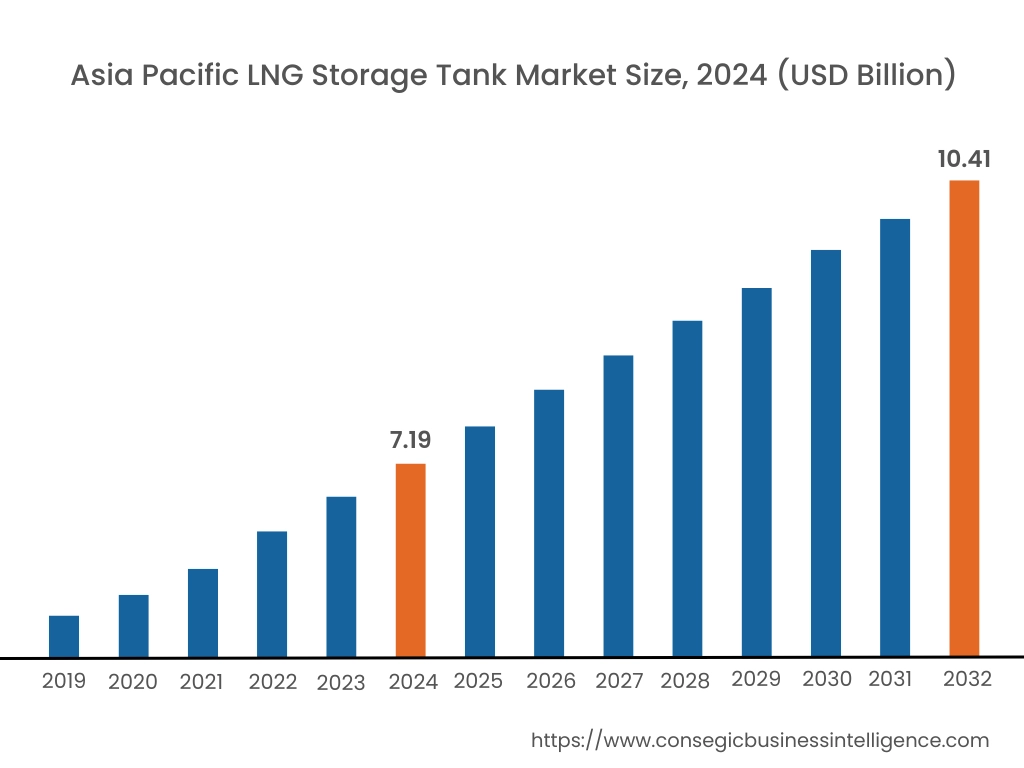
In 2024, Asia Pacific accounted for the highest LNG Storage Tank market share at 45.22% and was valued at USD 7.19 Billion and is expected to reach USD 10.41 Billion in 2032. In Asia Pacific, China accounted for a market share of 38.99% during the base year of 2024. The market in Asia Pacific region is driven by government incentives, growing consumer demand for sustainable mobility, and robust manufacturing capabilities, particularly in countries like China, South Korea, Japan, and India. Rapid industrialization, urbanization, and economic growth in these countries lead to significant energy consumption. The rise in the consumption of electricity is influencing the use of these storage tanks.
For instance,
- The data by EIA states that, in 2023, In 2023, the electric power sector accounted for about 96% of total U.S. utility-scale electricity generation, nearly all of which was sold to the other sectors.
Thus, as per the LNG Storage Tank market analysis, these factors create a strong upward trajectory for the Asia Pacific market, positioning it as a key region for players.
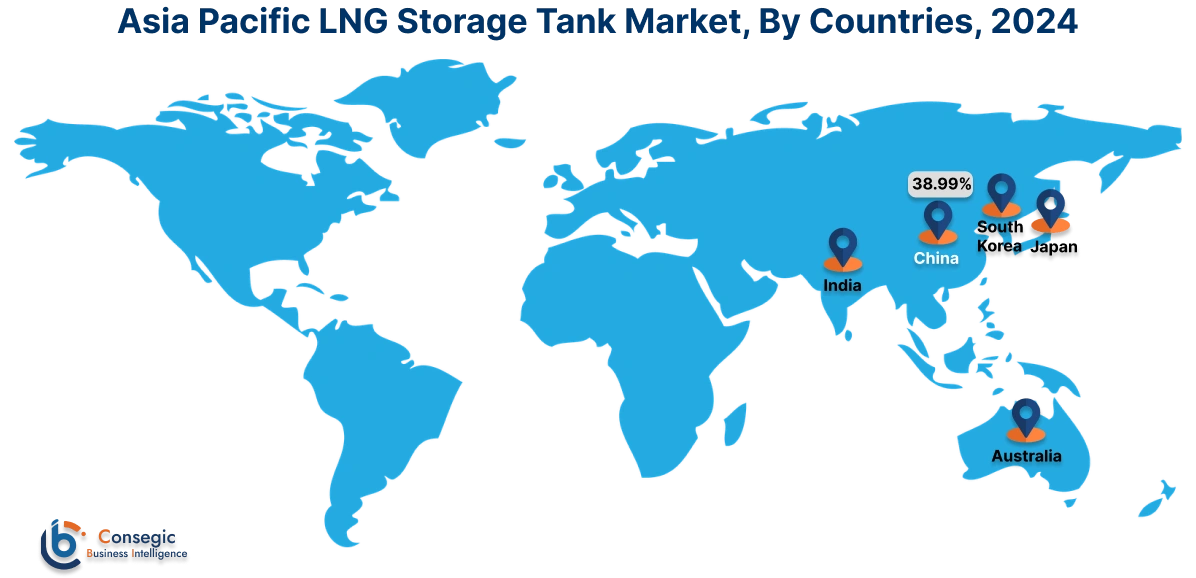
In Europe, the industry is experiencing the fastest growth with a CAGR of 7.8% over the forecast period. Above-ground double-domed storage tanks in Europe are mainly used for storing natural gas for industrial and fuel storage applications. These tanks are designed with a double wall or bunded structure to prevent leaks and environmental contamination and mainly consist of features like leak detection systems. Various European standards guide their design and construction. Thus, as per the LNG Storage Tank market analysis, the rise in the use of above ground storage tanks is driving the market trends in this region.
North America remains one of the major regions of oil and gas production, particularly fueled by the increased natural gas output. This large supply has transformed the region from an importer to a significant exporter of natural gas and compressed natural gas, primarily in its liquefied form. Subsequently, the adoption of oil and gas resources directly drives the imperative for expanded infrastructure, including a growing network of LNG storage tanks. Thus, as per the market analysis, the adoption of oil and gas and rise in the use of these storage tanks is propelling the growth of the market in this region.
One of the Latin American market trends is the region's focus on infrastructure development for power generation. In Latin America, the deployment of double containment LNG storage tanks is crucial for enhancing energy security and supporting the region's increasing reliance on natural gas for power generation and industrial use. These advanced tanks consist of a primary liquid-tight inner container and a secondary liquid-tight outer container, with an annular space between them, ensuring that any leakage from the primary tank is safely contained within the secondary barrier. Thus, these aforementioned factors are contributing to the LNG storage tank market growth.
LNG storage tanks play a major role in the transportation and logistics of Liquefied Natural Gas across the Middle East and Africa (MEA), a region increasingly vital to global energy supply and consumption. For transportation, they are important for entire LNG value chain, from liquefaction plants to regasification terminals. In the MEA region, this primarily involves large-scale, insulated containment systems on LNG carriers (ships) that transport vast volumes of LNG across oceans, connecting major producing nations to global markets, as well as supplying emerging regional demand. Thus, the aforementioned factors are influencing the LNG storage tank market growth in this region.
Top Key Players and Market Share Insights:
The Global LNG Storage Tank Market is highly competitive with major players providing products to the national and international markets. Key players are adopting several strategies in research and development (R&D) and product innovation to hold a strong position in the global LNG Storage Tank market. Key players in the LNG Storage Tank industry include
- IHI Corporation (Japan)
- McDermott (U.S.)
- CIMC ENRIC (China)
- Chart Industries (U.S.)
- Linde PLC (Ireland)
- VINCI Construction Grands Projets (France)
- Cryolor (France)
- INOX India Limited (India)
- ISISAN A.Ş. (Turkey)
- China Petrochemical Corporation (China)
Recent Industry Developments :
Facility Expansion:
- In 2024, CB&I, a wholly owned unrestricted subsidiary of McDermott, has been awarded a contract by Marsa Liquefied Natural Gas LLC, a joint venture between TotalEnergies and OQ for the engineering, procurement, construction (EPC) of a full containment concrete liquefied natural gas (LNG) storage tank, located in Oman's Port of Sohar.
LNG Storage Tank Market Report Insights :
| Report Attributes | Report Details |
| Study Timeline | 2019-2032 |
| Market Size in 2032 | USD 28.37 Billion |
| CAGR (2025-2032) | 7.6% |
| By Type |
|
| By End Use |
|
| By Region |
|
| Key Players |
|
| North America | U.S. Canada Mexico |
| Europe | U.K. Germany France Spain Italy Russia Benelux Rest of Europe |
| APAC | China South Korea Japan India Australia ASEAN Rest of Asia-Pacific |
| Middle East and Africa | GCC Turkey South Africa Rest of MEA |
| LATAM | Brazil Argentina Chile Rest of LATAM |
| Report Coverage |
|
